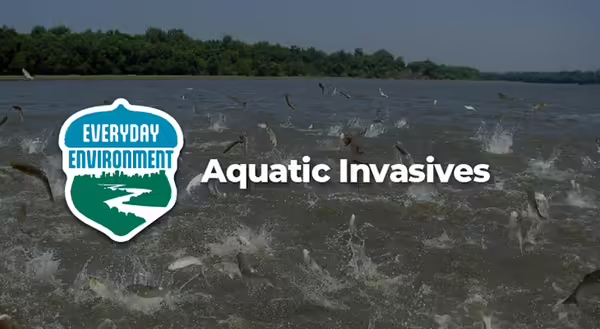
Unexpected guests can be a drag, especially when they show up uninvited, eat all your food, and wreck the place. Now, imagine if your unexpected guest could duplicate themselves from a single small fragment of their body!
Spare a thought for aquatic ecosystems — ponds, rivers, and lakes — when non-native plants and animals arrive unexpectedly. These aquatic invasive species are often the ultimate unwelcome houseguest, causing harm to native species and collectively costing humans millions of dollars annually in impacts and control.
From the Mississippi River to Lake Michigan, Illinois’ waters are incredible environmental and economic resources, supporting a diversity of plants and animals, providing drinking water for millions of people, and allowing for transportation and recreation. However, aquatic invasive species can threaten these resources. Some, like the highly-invasive plant hydrilla (Hydrilla verticillata), which can reproduce asexually from a fragment, have negative impacts on water quality and make it difficult to boat or swim. Others, like silver carp (Hypophthalmichthys molitrix), can have splashier impacts, literally, as this species is the infamous jumping fish you may have seen in videos!
Because it is often harder and more expensive to try and control aquatic invasive species once they become established in a new place, preventing their spread is critical to preserving our rivers and lakes. You can “Be a Hero” by taking the following steps to “Transport Zero” invasive species.
How you can prevent aquatic invasive species
Clean your boat and fishing gear after enjoying a day on the water
Many invasive species can be spread by hitchhiking on boats, trailers, and fishing gear. Even if you don’t see any visible plants, animals, or mud attached, microscopic eggs, larvae, fragments, or seeds can still be present. After a day spent boating or fishing, remember to clean, drain, and dry.
- Clean: Remove all visible mud, plants, and animals from your boat, trailer, and equipment before leaving the boat launch. It’s actually required by state law, Boat Registration and Safety Act 625 ILCS 45/5-23. Use a brush or pressure washer to clean hard-to-reach areas. If possible, rinse/flush interior compartments and the motor with hot water, at least 120°F.
- Drain: Empty all water from your boat, including the bilge, live wells, ballast tanks, and any other compartments that can hold water.
- Dry: Allow your boat and equipment to dry completely before using them in another body of water. If possible, let dry for at least five days, or use a towel to wipe things down thoroughly.
Don’t dump live bait
At the end of a long day of fishing, dispose of unwanted bait and worms in the trash instead of dumping your bucket into the water. Live minnows or shiners can be difficult to identify to the species level and might not be native to the places you are planning to fish. Additionally, a shipment of bait may sometimes have invasive species mixed in unknowingly. If you catch and keep your own live bait from one waterbody, don’t transport it for use at another waterbody.
Find new homes for unwanted pets
Beyond boating and fishing, many non-native animals are transported to areas in which they have never been because of their use as aquarium pets. Despite what Finding Nemo may have shown, most pets released into the wild, either intentionally or accidentally, will not survive. Those that do may become invasive and cause harm to native species.
If you can no longer care for an aquarium pet, try to find a new owner or seek advice on humane methods of disposal. Illinois-Indiana Sea Grant has compiled a network of pet shops in the Great Lakes region that may be able to help rehome a pet, and rehoming networks also exist for other locations.
And don’t forget about the aquarium water! Water can carry diseases, eggs, seeds, or plant parts that could become invasive if not disposed of properly.
This article was written by Katie O'Reilly, Aquatic Invasive Species Specialist with Illinois-Indiana Sea Grant. Photo Credit: Invasive Carp Regional Coordinating Committee.
Resources to learn more
- Illinois Extension, Aquatic Invasives
- Be a Hero, Transport Zero
- Great Lakes Aquatic Nonindigenous Species Information System
Thank you for reading!
Everyday Environment is a series of blogs, podcasts, webinars and videos on exploring the intricate web of connections that tie us to the natural world. Want to listen to us chat about this topic? Check out the podcast episode on this topic to hear more from the Everyday Environment team about aquatic invasive species.
Listen to the Podcast Sign Up for Everyday Environment Newsletter